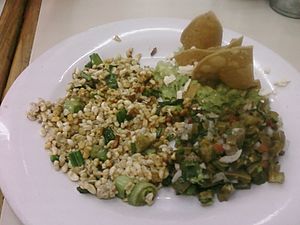Escamol facts for kids

Escamoles cooked in butter
|
|
| Alternative names | Mexican caviar |
|---|---|
| Place of origin | Mexico |
| Main ingredients | larvae and pupae of ants |
Escamoles (which means 'ant puree' in the Nahuatl language) are a special food from Mexico. They are often called Mexican caviar because they are considered a fancy dish. Escamoles are actually the edible larvae and pupae (young forms) of certain types of ants.
These ants are mostly from the species Liometopum apiculatum and L. occidentale. People usually eat escamoles in Mexico City and the areas around it.
Contents
A Taste of History
Escamoles have been a part of Mexican food for a very long time. People were already eating them during the time of the Aztecs. The Aztecs were an ancient civilization in Mexico. This shows how old and traditional this unique food is.
What Do Escamoles Taste Like?
When you try escamoles, you might be surprised by their flavor. They are often described as tasting buttery and nutty. Their texture is soft, a bit like cottage cheese. This makes them a unique and interesting ingredient in many dishes.
How Are Escamoles Harvested?
Finding escamoles is not easy! The ants that produce them build their nests underground. These nests are often found near the roots of plants like the Agave plant. Harvesting escamoles requires skill and knowledge. People carefully dig into the ground to find the ant nests. They collect the larvae and pupae without harming the ant colony too much. This careful process makes escamoles a special and sometimes expensive food.
How Are Escamoles Eaten?
Escamoles can be prepared in many delicious ways. They are often cooked simply with butter and garlic. Sometimes, they are served in tacos or omelettes. They can also be added to other dishes to give them a unique flavor and texture. Because they are considered a delicacy, you might find them in fancy restaurants.
Why Eat Insects?
Eating insects, like escamoles, is common in many parts of the world. This practice is called entomophagy. Insects can be a good source of protein and other nutrients. They also require less land and water to produce than traditional livestock. This makes them a sustainable and environmentally friendly food source.
See also
 In Spanish: Escamol para niños
In Spanish: Escamol para niños



